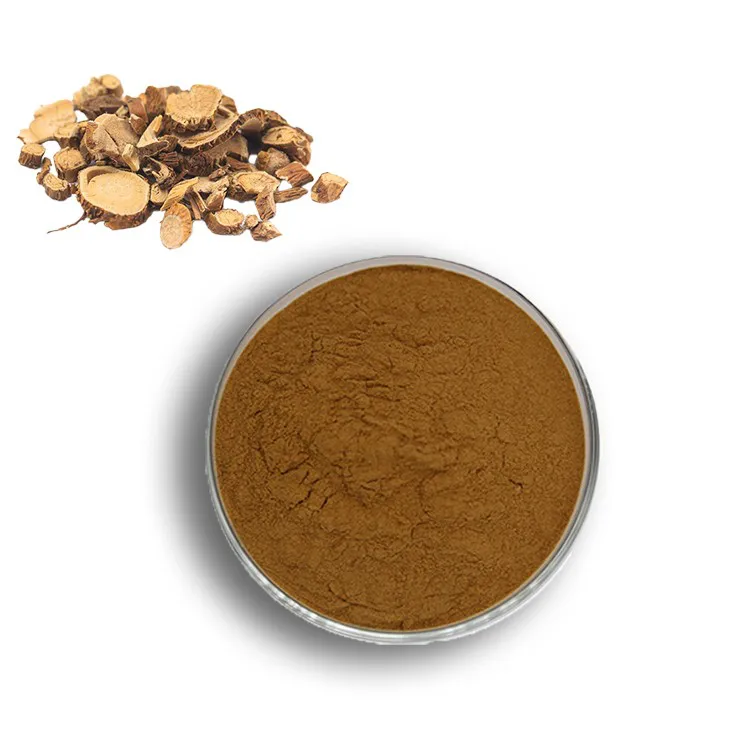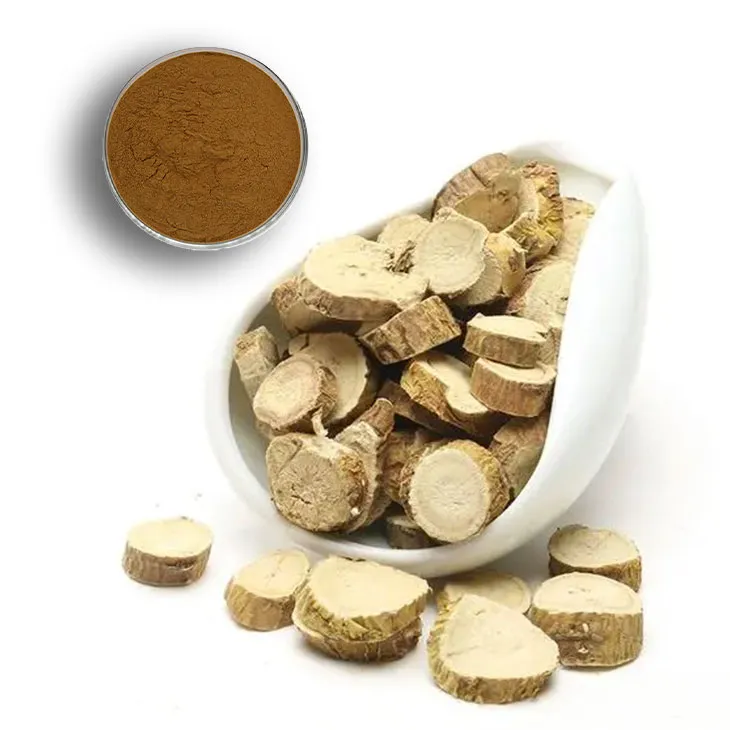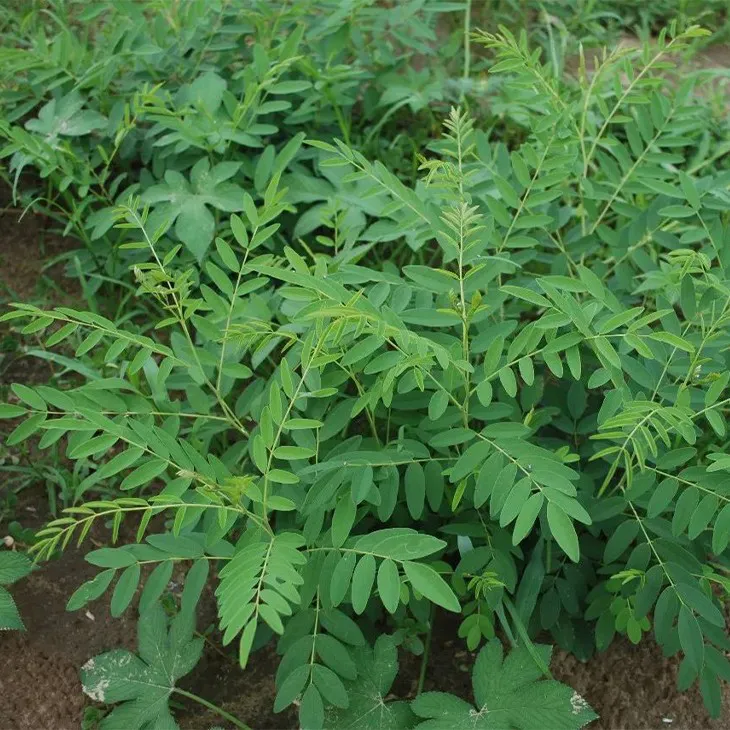- 0086-571-85302990
- sales@greenskybio.com
Extraction technology and production process of Sophora flavescens root extract.
2024-11-28

1. Introduction
Sophora flavescens root, also known as Kushen in Chinese traditional medicine, has been widely used for its various pharmacological properties. The extraction of Sophora Flavescens Root Extract is crucial to obtain the active components effectively. This article will explore different extraction technologies and the overall production process, with a focus on quality control measures.

2. Extraction Technologies
2.1. Solvent Extraction
Solvent extraction is one of the most common methods for extracting Sophora flavescens root extract.
- Alcohol extraction: Ethanol is often used as a solvent. Sophora flavescens roots are soaked in ethanol solutions with different concentrations. For example, a 70% ethanol solution can effectively extract alkaloids, flavonoids, and other active ingredients from the roots. The process usually involves soaking the roots in the ethanol solution for a certain period, such as 24 - 48 hours at room temperature. Then, the mixture is filtered to obtain the extract solution.
- Water extraction: Water can also be used as a solvent. Although water extraction is relatively simple and environmentally friendly, it may extract more impurities compared to alcohol extraction. In water extraction, the roots are boiled in water for a certain time, usually 1 - 3 hours. After boiling, the solution is filtered to get the water - based extract. However, some water - soluble polysaccharides may also be co - extracted, which may need further purification steps if the target is mainly alkaloids or flavonoids.
2.2. Supercritical Fluid Extraction (SFE)
Supercritical fluid extraction is a more advanced extraction method.
- Carbon dioxide (CO₂) is the most commonly used supercritical fluid in the extraction of Sophora flavescens root extract. Under supercritical conditions (temperature and pressure above the critical point of CO₂), CO₂ has properties similar to both gas and liquid. It can penetrate into the plant material easily and has high selectivity for different components.
- The advantages of SFE are obvious. It is a clean extraction method with no solvent residue in the final product. Moreover, it can operate at relatively low temperatures, which is beneficial for protecting the thermally sensitive components in Sophora flavescens roots. However, the equipment for SFE is relatively expensive, which limits its widespread application in small - scale production.
2.3. Microwave - Assisted Extraction (MAE)
Microwave - assisted extraction utilizes microwave energy to accelerate the extraction process.
- In MAE, the Sophora flavescens root samples are placed in a solvent (such as ethanol or water) and then irradiated with microwaves. The microwaves cause the polar molecules in the solvent and plant material to vibrate rapidly, increasing the mass transfer rate between the solvent and the active components in the roots. This method can significantly reduce the extraction time compared to traditional solvent extraction. For example, a normal solvent extraction may take 24 hours, while MAE can complete the extraction within 30 minutes to 2 hours.
- However, one of the challenges in MAE is to control the microwave power and irradiation time accurately. If the power is too high or the irradiation time is too long, it may lead to the degradation of some active components.

3. Comparison of Extraction Technologies
Efficiency:
- Microwave - assisted extraction (MAE) generally has the highest extraction efficiency among the three methods. It can complete the extraction in a relatively short time, which is very beneficial for large - scale production.
- Supercritical fluid extraction (SFE) also has a relatively high extraction rate, especially for some components with high selectivity. However, due to the complex operation process, the overall efficiency may be slightly lower than MAE in some cases.
- Solvent extraction, especially water extraction, is relatively time - consuming. Alcohol extraction is faster than water extraction, but still not as efficient as MAE and SFE in terms of extraction speed.
Environmental Impact:
- SFE is the most environmentally friendly method as it uses carbon dioxide, which is a non - toxic and non - flammable gas, and there is no solvent residue in the final product.
- Solvent extraction, especially when using organic solvents like ethanol, may produce solvent waste, which needs proper treatment to avoid environmental pollution. Water extraction is relatively more environmentally friendly, but the large - scale use of water also needs to consider water resource conservation.
- MAE also has some environmental considerations. Although it reduces the amount of solvent used and the extraction time, the energy consumption of the microwave equipment needs to be taken into account.

4. Production Process
4.1. Raw Material Preparation
Harvesting: The Sophora flavescens roots should be harvested at the appropriate time. Generally, they are harvested in autumn when the active components in the roots are at a relatively high level.
Cleaning and Drying: After harvesting, the roots need to be thoroughly cleaned to remove soil, stones, and other impurities. Then, they are dried. Drying can be carried out in the sun or in a drying chamber. The drying temperature should be controlled within a certain range. For example, in a drying chamber, the temperature can be set at 40 - 60°C to avoid excessive loss of active components due to high temperature.
4.2. Extraction
Depending on the selected extraction technology, the extraction process is carried out as described above. Whether it is solvent extraction, supercritical fluid extraction, or microwave - assisted extraction, strict operation procedures need to be followed to ensure the extraction effect.
4.3. Concentration and Drying
Concentration: After extraction, the obtained extract solution usually contains a large amount of solvent. The solution needs to be concentrated to reduce the solvent content. This can be achieved by methods such as vacuum evaporation. In vacuum evaporation, the extract solution is placed in a vacuum environment, and the solvent is evaporated at a lower temperature, which helps to protect the active components.
Drying: After concentration, the extract is further dried to obtain a solid product. Spray drying is a commonly used drying method. In spray drying, the concentrated extract is sprayed into a hot air stream, and the solvent is rapidly evaporated, leaving the solid extract powder.
4.4. Quality Control
Component Analysis: Throughout the production process, component analysis is carried out to ensure that the main active components in the Sophora Flavescens Root Extract, such as alkaloids and flavonoids, are within the specified range. High - performance liquid chromatography (HPLC) is often used for this purpose. HPLC can accurately analyze the content of different components in the extract.
Impurity Detection: Detection of impurities is also crucial. Impurities may come from the raw materials, solvents, or the production process itself. For example, heavy metals and pesticide residues need to be detected. Atomic absorption spectrometry can be used to detect heavy metals, and gas chromatography can be used to detect pesticide residues.
Microbial Limit Testing: Microbial limit testing is necessary to ensure the safety of the product. The number of bacteria, fungi, and other microorganisms in the extract should be within the allowable limits. Standard microbiological testing methods are used for this purpose.
5. Conclusion
In conclusion, the extraction technology and production process of Sophora Flavescens Root Extract are multi - faceted. Different extraction technologies have their own advantages and disadvantages in terms of efficiency and environmental impact. The production process needs to pay attention to raw material preparation, extraction, concentration, drying, and quality control. By comprehensively considering these factors, high - quality Sophora flavescens root extract can be produced, which can meet the requirements of various applications in the fields of medicine, cosmetics, and health products.
FAQ:
1. What are the common extraction methods for Sophora flavescens root extract?
Some common extraction methods for Sophora flavescens root extract include solvent extraction, such as using ethanol or methanol as solvents. Supercritical fluid extraction is also a method that has been explored, which often uses carbon dioxide as the supercritical fluid. Another method could be microwave - assisted extraction, which can enhance the extraction efficiency by using microwave energy.
2. How does solvent extraction work in obtaining Sophora flavescens root extract?
In solvent extraction, the Sophora flavescens root material is soaked in a suitable solvent (e.g., ethanol). The active compounds in the root dissolve into the solvent over a certain period of time. This is usually followed by filtration to separate the solid residue from the solvent - containing the extract. Then, the solvent is evaporated to obtain the concentrated extract. The choice of solvent depends on factors like the solubility of the desired compounds and safety considerations.
3. What are the advantages of supercritical fluid extraction for Sophora flavescens root extract?
Supercritical fluid extraction has several advantages. Firstly, carbon dioxide, which is often used as the supercritical fluid, is non - toxic, non - flammable, and environmentally friendly. Secondly, it can provide high selectivity, meaning it can target specific compounds more effectively compared to some other methods. Also, it can operate at relatively low temperatures, which helps to preserve the thermally labile compounds in the Sophora flavescens root extract.
4. How is quality control ensured during the production process of Sophora flavescens root extract?
Quality control during the production of Sophora flavescens root extract involves several aspects. Firstly, the raw materials are carefully sourced and inspected to ensure they meet the required standards. During the extraction process, parameters such as temperature, pressure (in the case of methods like supercritical fluid extraction), and extraction time are closely monitored. Analytical techniques like high - performance liquid chromatography (HPLC) are used to determine the composition and purity of the extract. Additionally, microbial and heavy metal contamination are also tested to ensure the safety and quality of the final product.
5. What factors need to be considered for the efficiency of extraction of Sophora flavescens root extract?
Several factors affect the extraction efficiency. The particle size of the Sophora flavescens root material is important; smaller particles generally provide a larger surface area for extraction, leading to higher efficiency. The type and concentration of the solvent (if solvent extraction is used) play a role. Temperature also has an impact; within a certain range, increasing the temperature can enhance the solubility of the compounds and thus improve the extraction efficiency. The extraction time needs to be optimized; too short may result in incomplete extraction, while too long may cause degradation of some compounds.
Related literature
- Advanced Extraction Technologies for Medicinal Plant Extracts"
- "Quality Control in Herbal Extract Production"
- "Sophora flavescens: Chemical Constituents and Their Bioactivities"
- ▶ Hesperidin
- ▶ Citrus Bioflavonoids
- ▶ Plant Extract
- ▶ lycopene
- ▶ Diosmin
- ▶ Grape seed extract
- ▶ Sea buckthorn Juice Powder
- ▶ Fruit Juice Powder
- ▶ Hops Extract
- ▶ Artichoke Extract
- ▶ Mushroom extract
- ▶ Astaxanthin
- ▶ Green Tea Extract
- ▶ Curcumin
- ▶ Horse Chestnut Extract
- ▶ Other Product
- ▶ Boswellia Serrata Extract
- ▶ Resveratrol
- ▶ Marigold Extract
- ▶ Grape Leaf Extract
- ▶ New Product
- ▶ Aminolevulinic acid
- ▶ Cranberry Extract
- ▶ Red Yeast Rice
- ▶ Red Wine Extract
-
Sugarcane Extract
2024-11-28
-
Hawthorn powder
2024-11-28
-
Aminolevulinic acid
2024-11-28
-
Avocado Extract Powder
2024-11-28
-
Centella Asiatica Extract
2024-11-28
-
Lemon Extract
2024-11-28
-
Artichoke Leaf Extract
2024-11-28
-
Wheat Germ Extract
2024-11-28
-
Lotus leaf extract
2024-11-28
-
Gynostemma pentaphyllum extract
2024-11-28





















